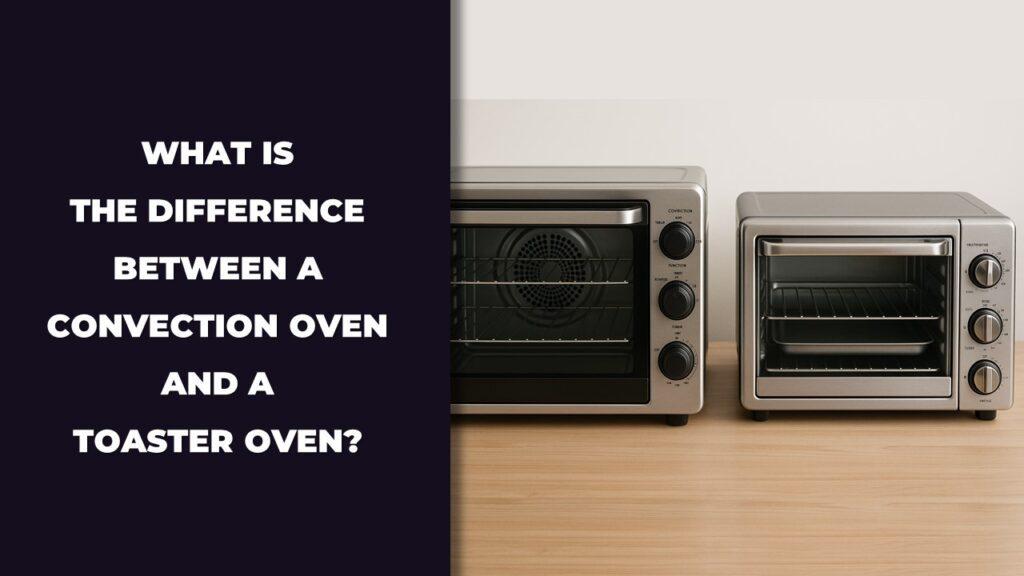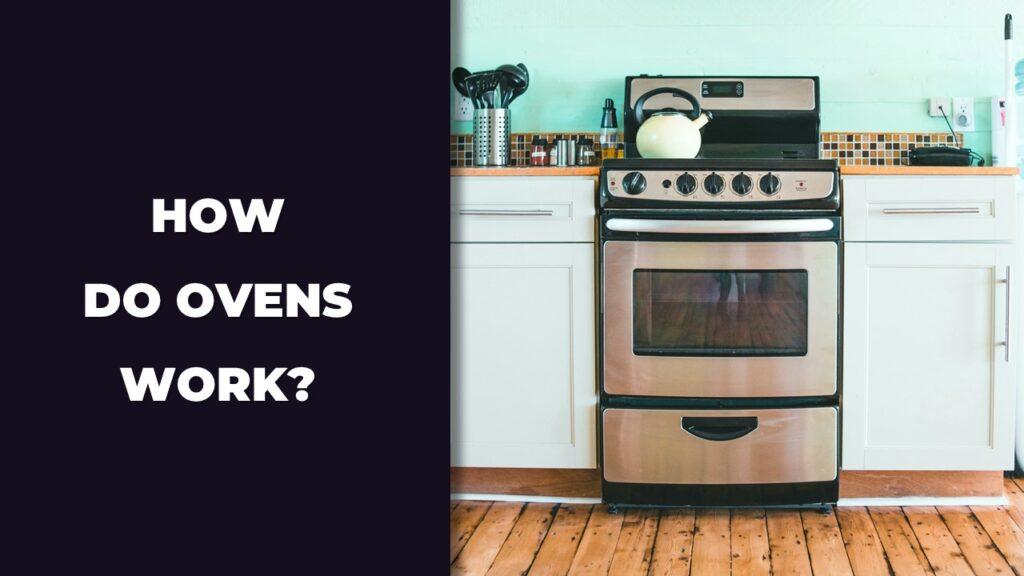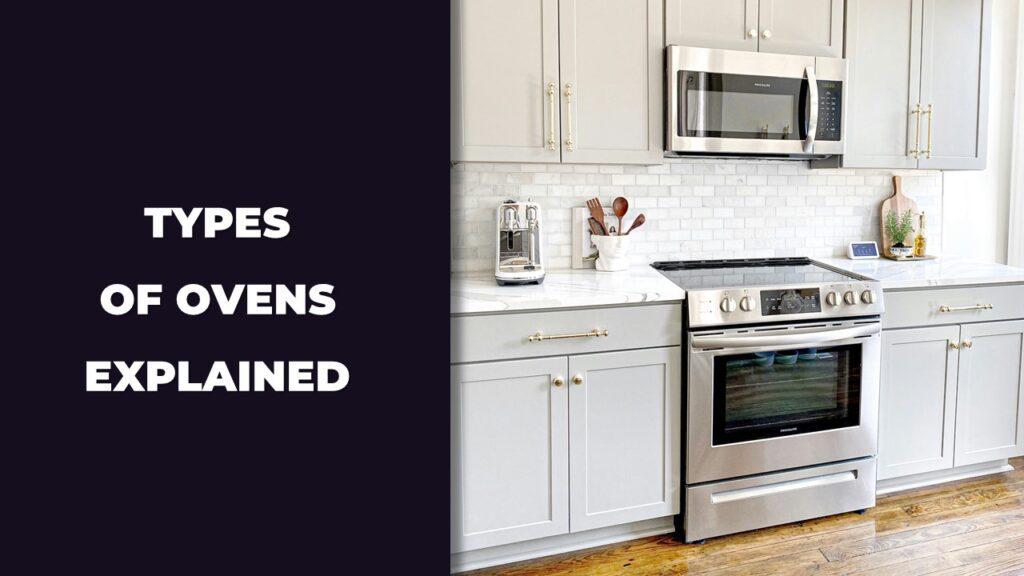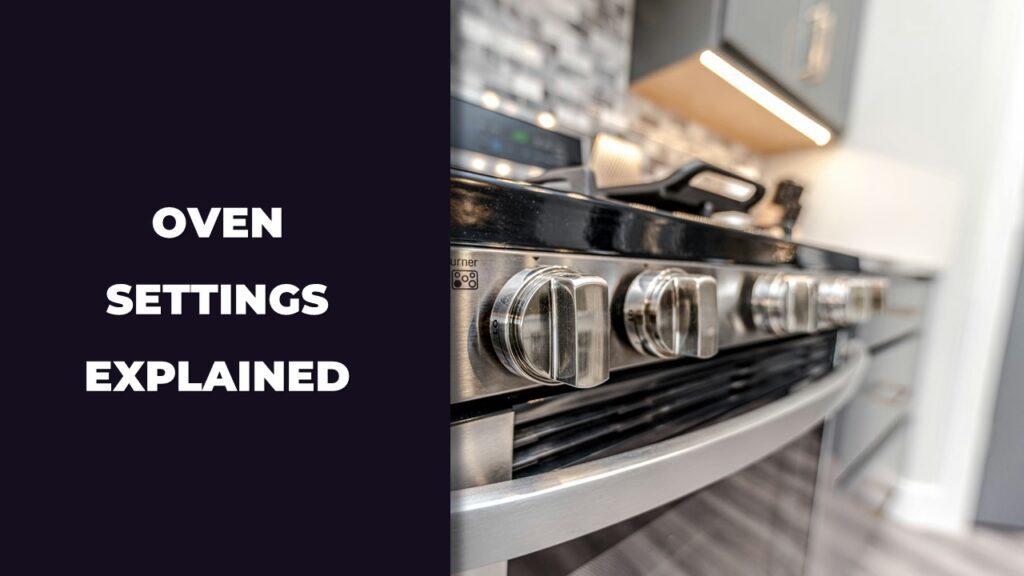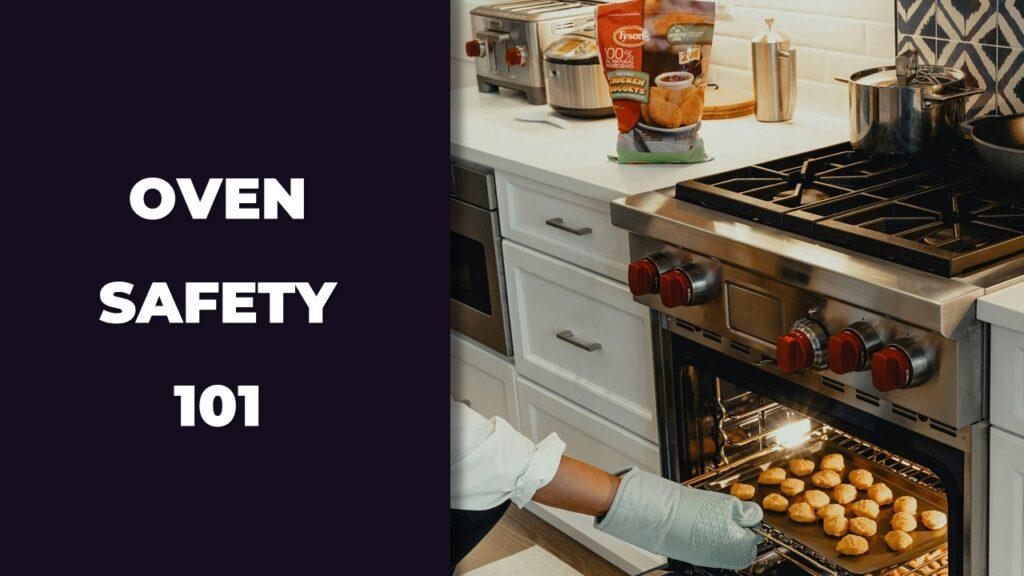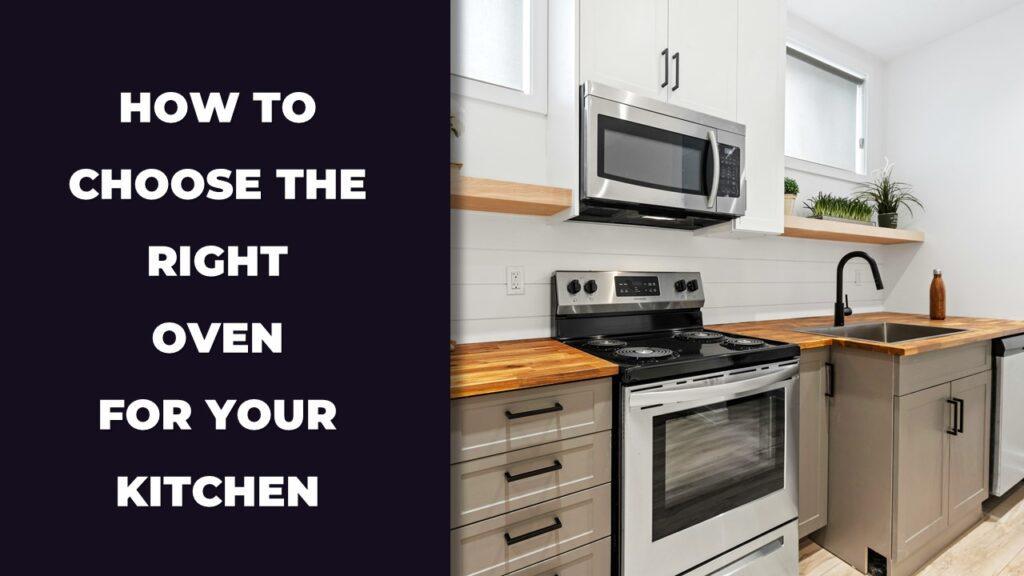If you’re looking for the best microwave ovens in 2025, you’ll find that modern models now combine speed, energy efficiency, and smart features in compact designs. Whether you’re heating leftovers, defrosting frozen meals, or cooking from scratch, today’s microwave ovens make everyday cooking faster and more precise—with intuitive controls and sleek finishes that fit perfectly in any kitchen.
After testing and comparing the top models this year, the TOSHIBA EM131A5C-BS deliver reliable power and easy one-touch presets, while the BLACK+DECKER EM720CB7 offers great functionality at an affordable price. The COMFEE EM720CPL-PMB is ideal for budget-conscious users, and the anasonic Microwave Oven NN-SN686S stands out for its inverter technology that ensures even heating. If you need something smaller, the TOSHIBA ML-EM09PA(BS) packs efficiency and performance into a compact footprint.
In this guide, we’ve tested and compared each microwave oven for power, heating consistency, ease of use, noise level, and durability to help you choose the right one for your cooking needs in 2025.
We’re reader-supported. When you buy through links on our site, we may earn an affiliate commission. As an Amazon Associate, we earn from qualifying purchases at no extra cost to you.
Best Microwaves: Our Top Picks
- Best Overall: TOSHIBA EM131A5C-BS Countertop Microwave
- Best Value Pick: BLACK+DECKER EM720CB7 Digital Microwave
- Best Budget Option: COMFEE EM720CPL-PMB Countertop Microwave
- Best Inverter Microwave: Panasonic Microwave Oven NN-SN686S
- Best Small Microwave: TOSHIBA ML-EM09PA(BS) Small Microwave
- Best for Ease of Use: Breville BMO850BSS Smooth Wave
- Best Mid-Size Pick: Chefman Countertop Microwave
- Best Stainless Option: Farberware FMWO11AHTBKB
- Best Large Microwave: Toshiba ML-EM62P(SS) Large Countertop Microwave
- Best Digital Microwave: BLACK+DECKER Digital Microwave Oven
- Best Retro Design: Galanz GLCMKA07BER-07 Retro
- Best Starter Option: Farberware Countertop Microwave 700
- Best Mid-Range Performance: SHARP Countertop Microwave Oven
- Best Multifunction Microwave: GE GCST10A1WSS 4-in-1 Microwave Oven
- Best Over-the-Range Microwave: BLACK+DECKER Over the Range Microwave Oven
1. Best Overall: TOSHIBA EM131A5C-BS Countertop Microwave
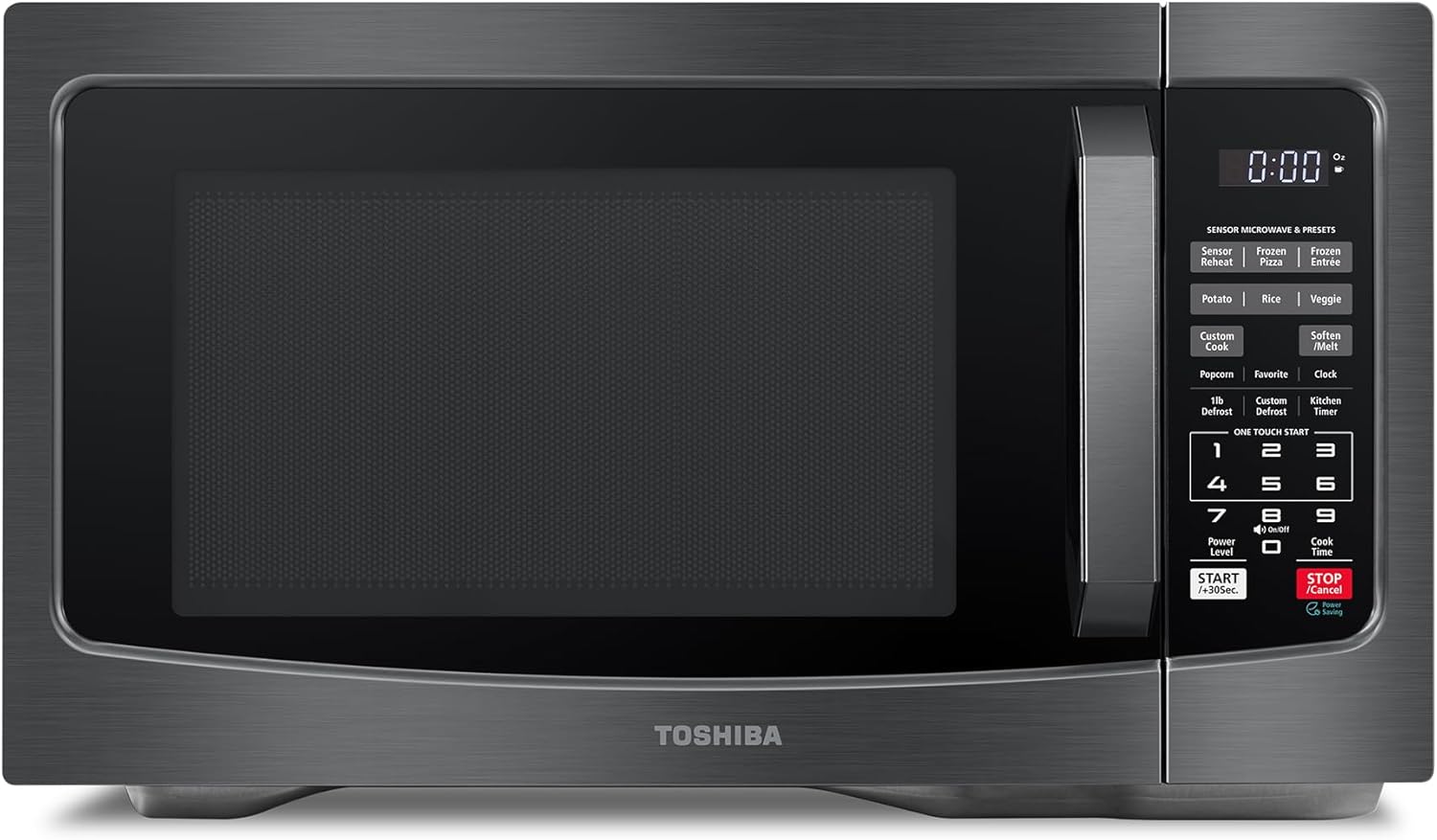
Key Details:
- Capacity: 1.2 cu. ft. with 12.4” turntable
- Power: 1000 watts output, 10 power levels
- Smart Humidity Sensor with 6 auto menus
- ECO mode + mute option for quiet operation
- Dimensions: 20.6 x 16 x 11.8 inches
Finding a reliable all-rounder can be tough, but this Toshiba countertop microwave fits most homes perfectly. The 1.2 cu. ft. size is roomy enough for casseroles yet still compact for apartment kitchens. Its smart humidity sensor was designed to automatically adjust cooking time, and during use it consistently delivered evenly heated leftovers without the dry, rubbery edges common in cheaper models.
The 1000-watt output strikes a balance between speed and energy efficiency, making it fast enough for reheating but still economical in ECO mode. Small touches like the option to mute the buzzer are surprisingly practical for families who don’t want loud alerts during late-night cooking. This ease of use is similar to the appeal of compact countertop microwave ovens when space and convenience are top priorities.
Another plus is durability. The stainless steel build holds up well against fingerprints and everyday wear, and the digital controls are easy to master. In testing, sensor reheat worked reliably across pizza, vegetables, and pasta, adjusting automatically for doneness.
For buyers wanting one dependable unit to handle daily reheating, frozen meals, and quick cooking, this Toshiba offers excellent value. It’s not a multifunction convection model, but paired with a dedicated convection oven it can round out a modern kitchen setup.
Pros:
- Smart humidity sensor delivers consistent results
- Spacious 1.2 cu. ft. capacity fits family needs
- Mute option + ECO mode for quiet, efficient use
- Durable stainless steel build with easy-to-clean interior
Cons:
- No convection or grilling options
- Slightly larger footprint than compact units
2. Best Value Pick: BLACK+DECKER EM720CB7 Digital Microwave
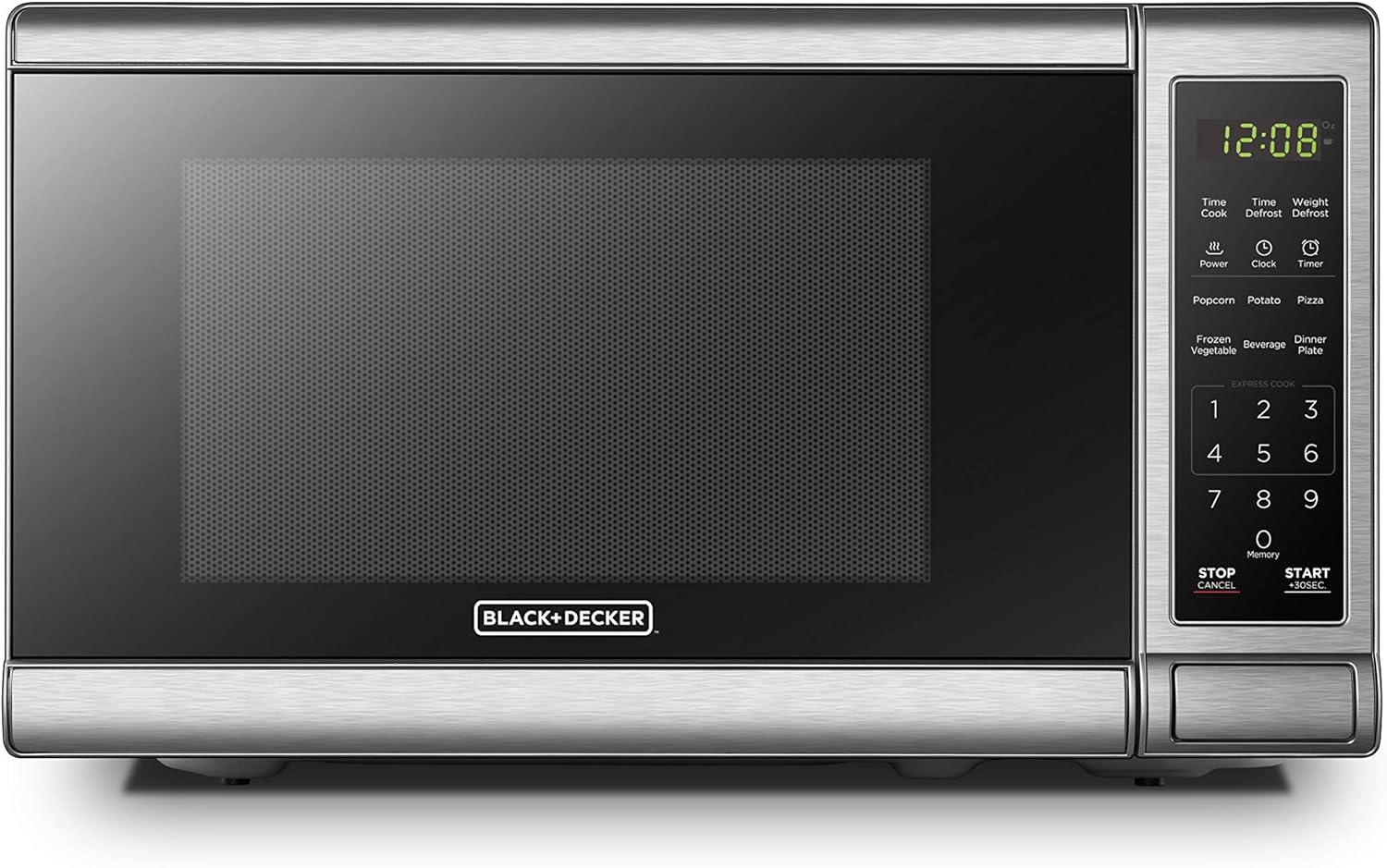
Key Details:
- Capacity: 0.7 cu. ft., 10” turntable
- Power: 700 watts with 10 settings
- Pre-programmed buttons for common foods
- Child safety lock for extra protection
- Dimensions: 17.3 x 13 x 10.2 inches
For buyers on a budget who still want a trusted brand, the BLACK+DECKER EM720CB7 is one of the top-selling compact microwaves under $100. At 0.7 cu. ft., it doesn’t take up much counter space, making it a practical choice for dorms, offices, or small kitchens.
During testing, the express cooking and one-touch buttons handled popcorn, potatoes, and reheats without fuss. Its 700 watts aren’t as powerful as larger models, but for light everyday use it was dependable. The child lock is a thoughtful addition, ensuring safe operation in homes with kids.
The stainless steel design also looks sleeker than many entry-level appliances. It shares a similar compact philosophy with models often compared in the over-the-range microwave category, but without the ventilation complexity.
Overall, this BLACK+DECKER shines as a starter microwave—simple, reliable, and easy to use. It’s not the fastest for cooking raw ingredients, but for reheating meals, warming drinks, or quick snacks, it’s a solid choice for budget-conscious buyers.
Pros:
- Affordable price with reliable brand backing
- Pre-programmed buttons for quick meals
- Compact design suits small spaces
- Child lock adds peace of mind
Cons:
- 700 watts feels slow compared to 1000W units
- Limited capacity for larger dishes
3. Best Budget Option: COMFEE EM720CPL-PMB Countertop Microwave
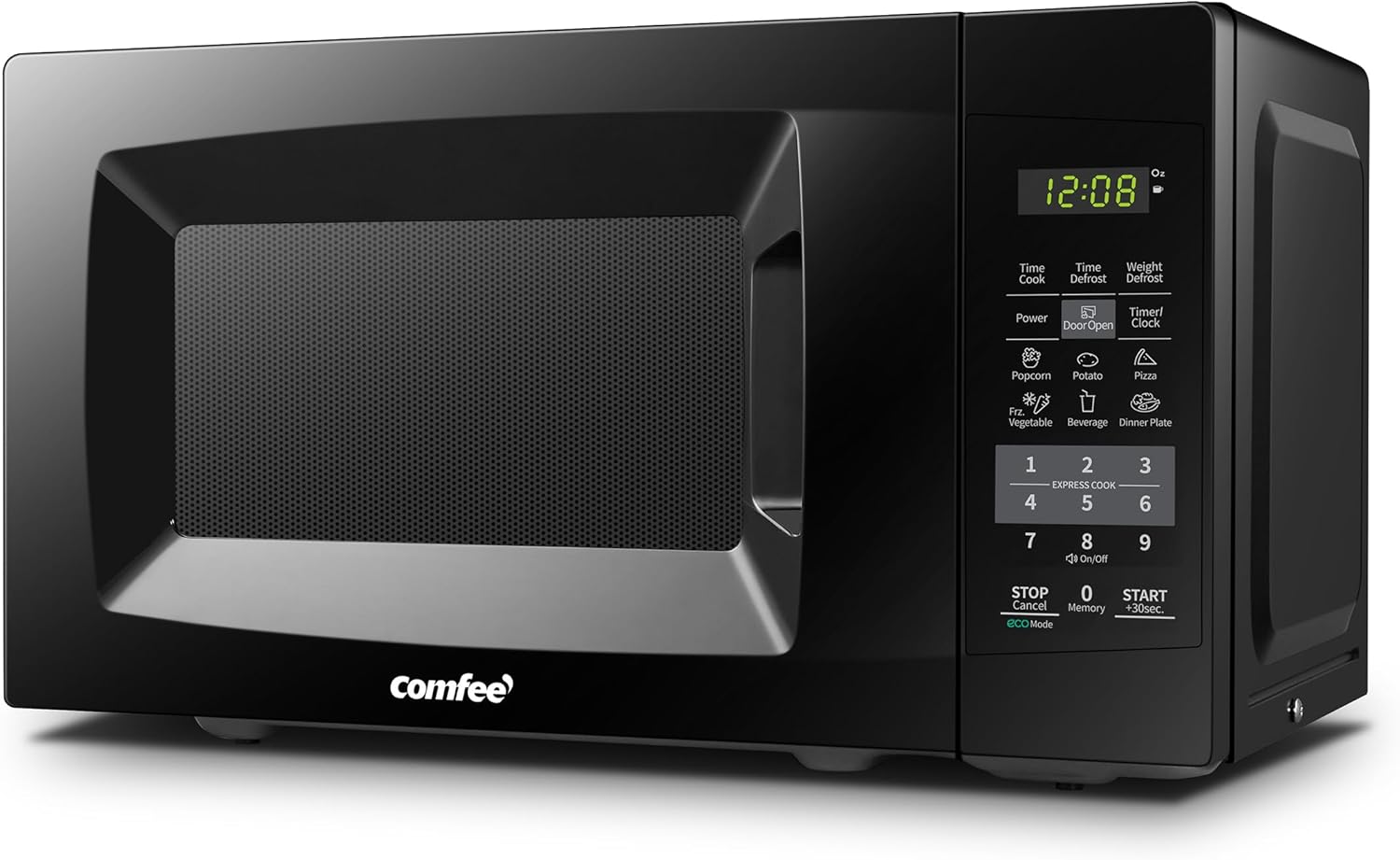
Key Details:
- Capacity: 0.7 cu. ft., 10” glass turntable
- Power: 700 watts with 11 levels
- ECO mode reduces standby power by 50%
- Mute button for silent operation
- Dimensions: 17.3 x 13 x 10.2 inches
For those who want affordability paired with thoughtful features, the COMFEE EM720CPL-PMB stands out. It keeps the footprint small but adds energy-saving and quiet operation modes that aren’t always found in budget units.
The ECO mode cuts down on wasted power, while the mute option eliminates annoying beeps—ideal in shared apartments or dorms. During testing, it ran quietly and reheated evenly, making it a better long-term option than some no-name brands in the same size class.
With 11 power levels, it offers slightly more precision than typical compact microwaves. This helps when warming leftovers or defrosting smaller portions. While it doesn’t have the larger interior of family-sized models, its functionality makes it a good everyday choice.
For compact living, it’s comparable to what a convection toaster oven offers for versatility, though here the focus is on reheating and quick meals. It’s a smart budget microwave for those who want more than just the bare basics.
Pros:
- ECO mode saves energy during standby
- Silent operation with mute button
- 11 power levels for better control
- Compact size fits tight spaces
Cons:
- 700W slower than mid-range units
- Small interior limits large dish use
4. Best Inverter Microwave: Panasonic Microwave Oven NN-SN686S
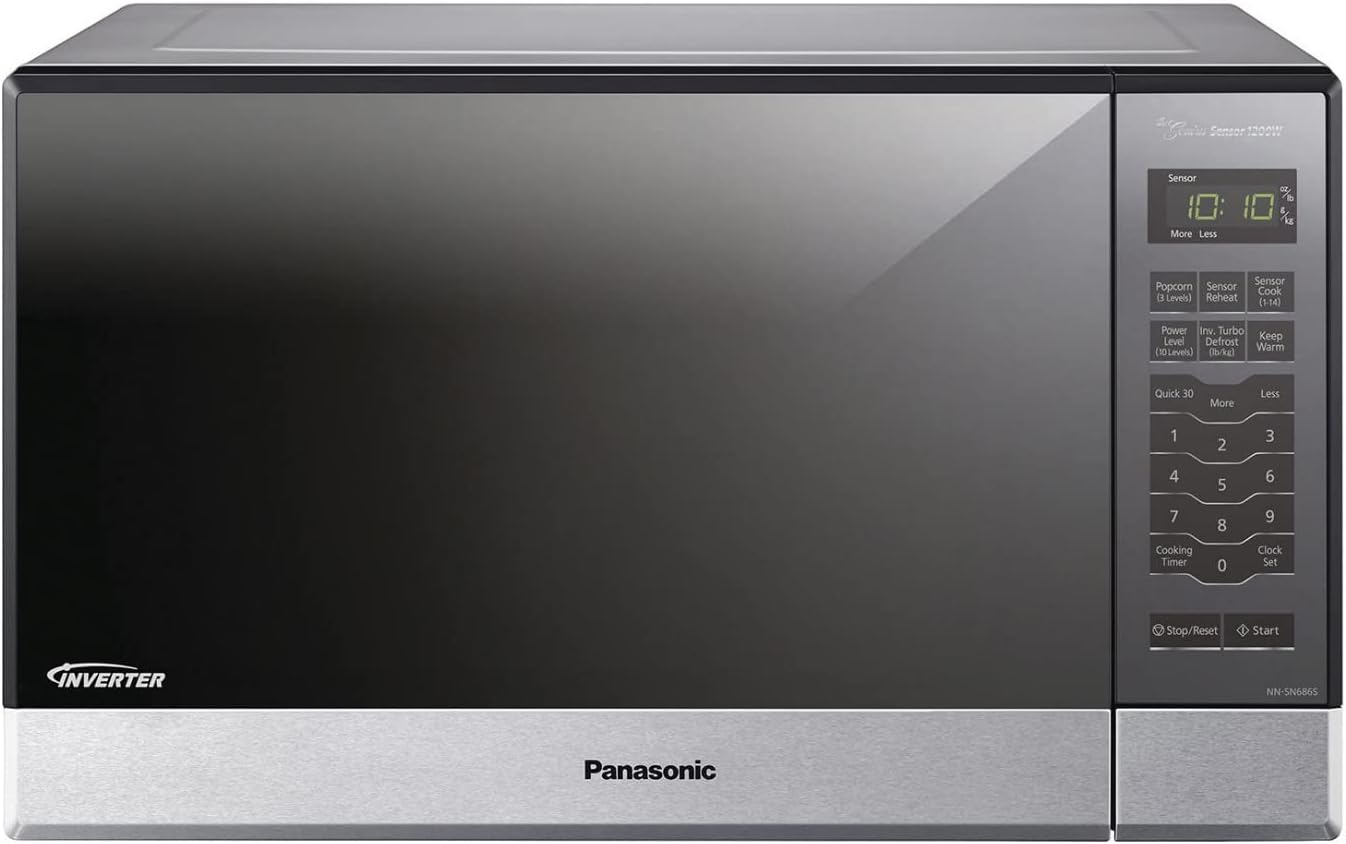
Key Details:
- Capacity: 1.2 cu. ft. with 13.4” turntable
- Power: 1200W cooking output, 1480W input
- Features: Inverter technology, Genius Sensor, Turbo Defrost
- Presets: 14 auto menu items, quick minute, keep warm
- Dimensions: 20.7” W x 15.8” D x 12.2” H
Panasonic has long been known for precision cooking, and the NN-SN686S is a standout choice for those seeking inverter technology. Unlike traditional microwaves that pulse power on and off, inverter heating delivers a constant flow of energy, which results in evenly cooked meals from edge to center. During testing, this was especially noticeable when reheating soups and pasta, where hot and cold spots are often an issue.
The Genius Sensor feature takes out the guesswork by automatically adjusting time and power based on the steam released from food. Combined with 14 preset menu items, it makes daily tasks like reheating leftovers, defrosting meat, or cooking oatmeal more reliable. Turbo Defrost also sped up thawing times compared to standard models, keeping meats safer to cook afterward.
Despite its high power, the microwave is compact and efficient. It has a sleek stainless steel design that works well in modern kitchens, and the lighter body makes it easier to move compared to larger units. Its keep-warm function also adds convenience, maintaining soups and sauces at serving temperature without overcooking.
For buyers comparing large-capacity models to more advanced designs, this Panasonic shows how much difference inverter technology can make—offering consistent results closer to what you’d expect from a full-sized convection-style appliance.
Pros:
- Inverter tech provides smooth, even heating
- Genius Sensor adjusts time automatically
- Turbo Defrost is faster than standard defrost
- Keep-warm function is a handy bonus
Cons:
- Stainless exterior shows fingerprints easily
- Slightly smaller capacity than large family units
5. Best Small Microwave: TOSHIBA ML-EM09PA(BS) Small Microwave
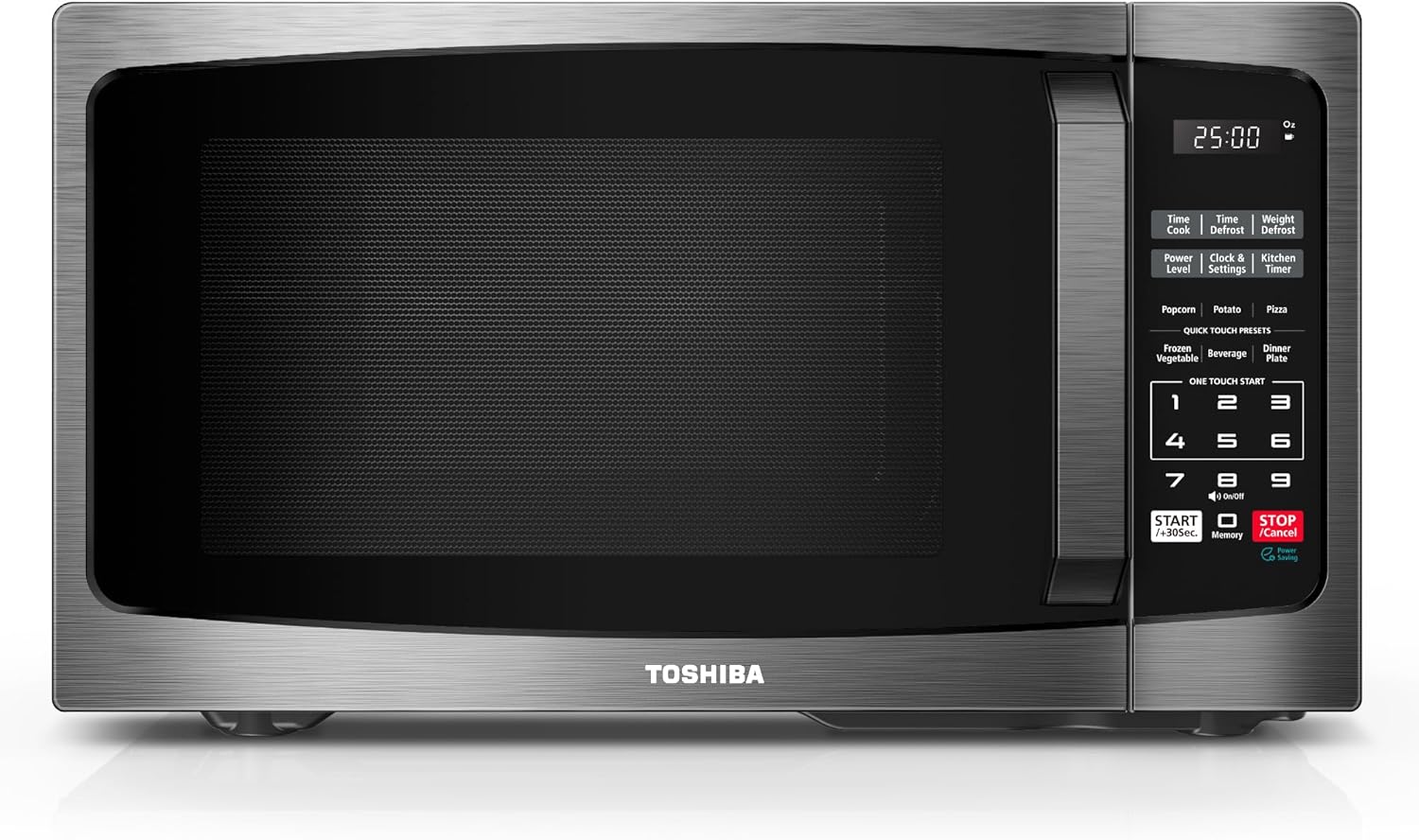
Key Details:
- Capacity: 0.9 cu. ft., 10.6” turntable
- Power: 900 watts with 11 levels
- Six auto menus with one-touch start
- Two-step child lock for safety
- Dimensions: 18.7 x 14.7 x 10.7 inches
For apartments or condos where space matters but a little more capacity is needed than 0.7 cu. ft., the Toshiba ML-EM09PA(BS) is a standout. At 0.9 cu. ft., it comfortably handles dinner plates without taking over counter space.
In testing, its 900 watts gave noticeably quicker results than smaller 700W units. Defrost and one-touch start worked consistently, and the LED lighting made it easy to check food without opening the door. The two-step child lock is one of the safest designs, preventing accidental starts.
This model feels sturdier than most compact picks, with the stainless steel build holding up well. Its presets simplify everyday use, while manual controls offer flexibility for custom cooking. It delivers that sweet spot of compact design plus extra performance.
For renters or students who want longevity in a smaller package, this Toshiba is an excellent compromise. Those looking for even more versatile cooking can pair it with an air fryer toaster oven for baking and crisping, while the microwave remains a daily workhorse.
Pros:
- 900 watts is faster than compact 700W models
- Two-step child lock adds safety for families
- Compact yet roomy enough for dinner plates
- Durable stainless steel design
Cons:
- Not as spacious as 1.1–1.2 cu. ft. models
- Limited advanced features (no convection)
6. Best for Ease of Use: Breville BMO850BSS Smooth Wave
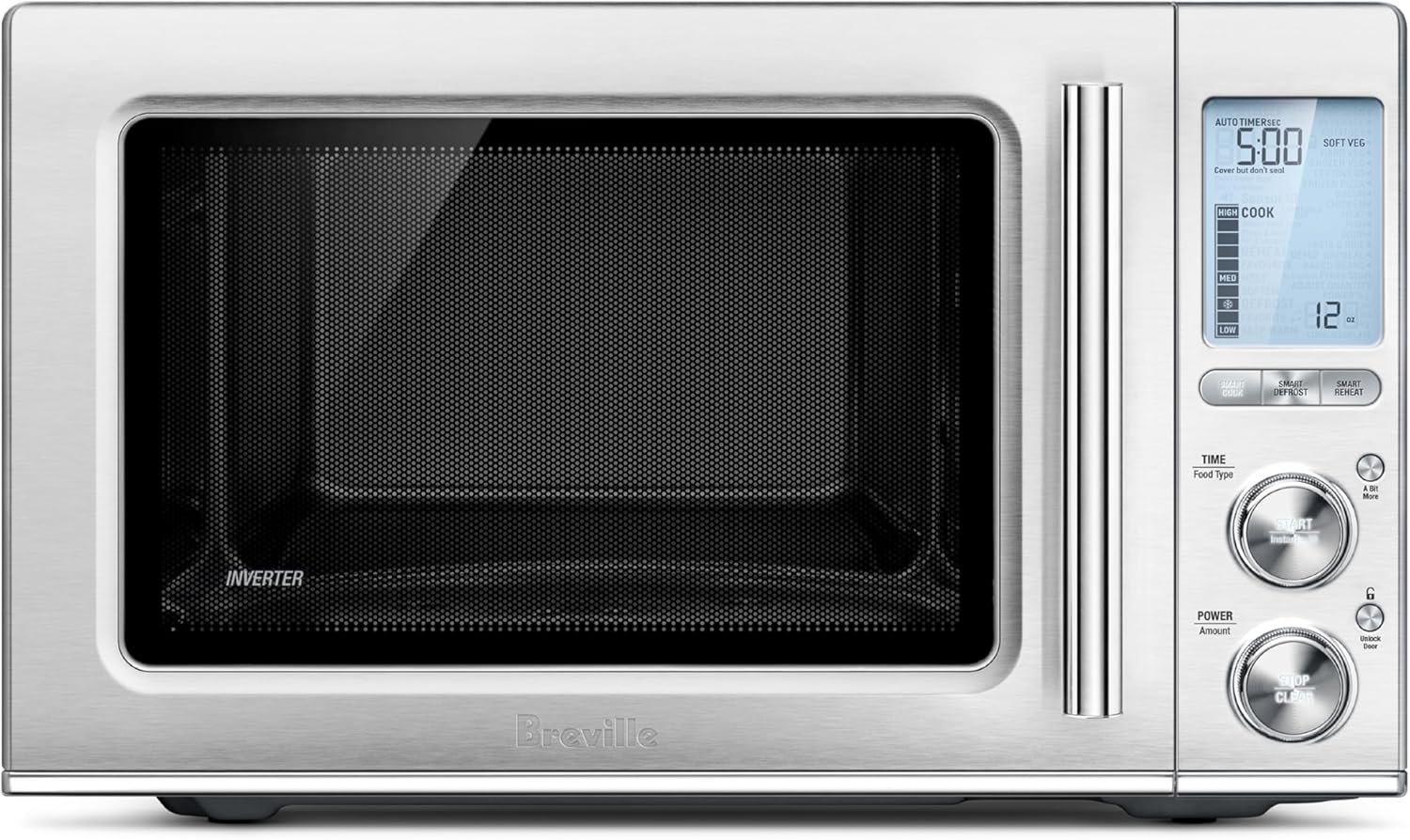
Key Details:
- Capacity: 1.2 cu. ft. with 8.75” turntable
- Power: 1250 watts with Power Smoothing Inverter
- Features: Sensor iQ, soft-close door, shortcuts panel
- Presets: 15 smart menu options
- Dimensions: 20.43” W x 19” D x 12.44” H
The Breville Smooth Wave earns its title as the best for ease of use by combining premium build quality with intuitive controls. Its standout feature is Sensor iQ technology, which automatically detects steam and adjusts cooking time and power for perfect results. Everyday foods like pizza, soup, and pasta were reheated with balanced heat distribution, avoiding dried edges or cold centers.
Another highlight is the Power Smoothing Inverter, which ensures a steady flow of energy. Instead of the harsh start-stop cycle of conventional microwaves, this creates gentle and even heating. The result is more precise reheats, delicate defrosting, and greater consistency for a wide range of foods.
User convenience is clearly at the heart of its design. The shortcuts panel inside the door gives one-touch access for melting butter, softening chocolate, or reheating pizza, making it especially practical for families. The soft-close door is 80% quieter than typical microwave doors, and the overall noise reduction makes it one of the most pleasant models to use daily.
Though it comes at a premium price point, the Breville Smooth Wave delivers quality-of-life upgrades that make a real difference. For kitchens where usability and precision matter as much as power, it’s a refined option that pairs well with other high-end oven setups.
Pros:
- Sensor iQ delivers smart, consistent cooking
- Quiet operation with soft-close door
- Shortcuts panel simplifies everyday tasks
- High-quality brushed stainless finish
Cons:
- More expensive than standard models
- Smaller turntable limits oversized dishes
7. Best Mid-Size Pick: Chefman Countertop Microwave
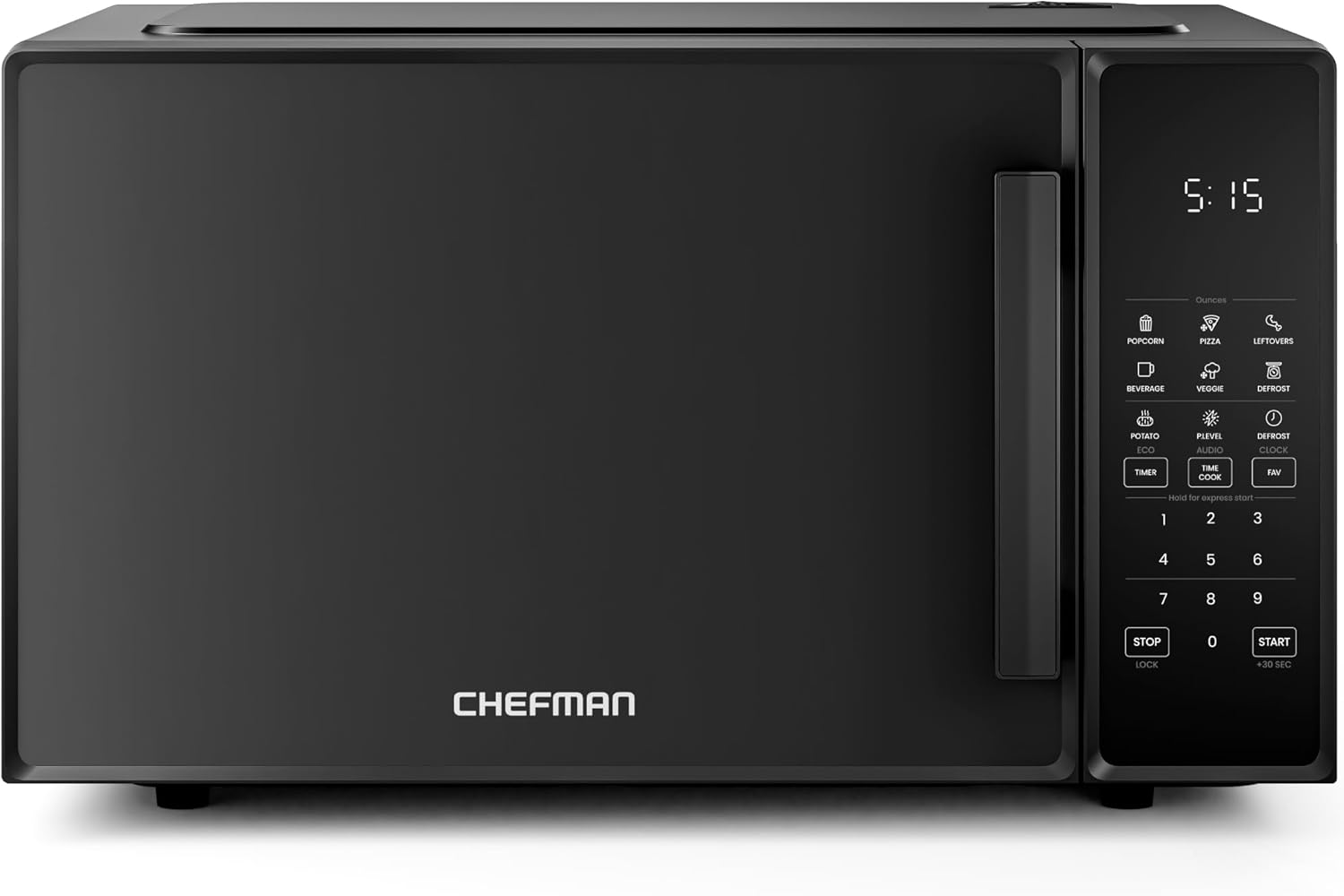
Key Details:
- Capacity: 1.1 cu. ft., compact but roomy
- Power: 1000 watts with 10 levels
- Six one-touch cooking presets
- ECO mode + mute button for quiet use
- Dimensions: 20.1 x 14.5 x 12 inches
This Chefman microwave sits in the sweet spot for families who want a mid-size option with a modern look. At 1.1 cu. ft., it doesn’t dominate counter space yet can still handle full-size dinner plates and larger bowls. In everyday use, the 1000-watt output meant faster reheating compared to 700W or 900W units.
Features like the +30 second button and memory presets make daily cooking easier. For households that want to cut down on noise, the mute option is handy, especially at night. Its build feels durable, with controls that remain intuitive for anyone using it the first time.
Performance-wise, it cooked evenly across pizza, potatoes, and beverages when tested, and the ECO mode was effective in lowering standby energy use. The addition of a child safety lock also makes it well-suited for families.
Buyers considering a Chefman may also look at a double wall oven if kitchen renovations are in the plans, but for countertop convenience, this model offers practical performance at an accessible price.
Pros:
- Compact size with ample interior
- 1000W ensures quicker results than budget picks
- ECO + mute mode add convenience
- Safety lock protects against accidental use
Cons:
- Lacks advanced convection or grilling
- Exterior shows fingerprints easily
8. Best Stainless Option: Farberware FMWO11AHTBKB
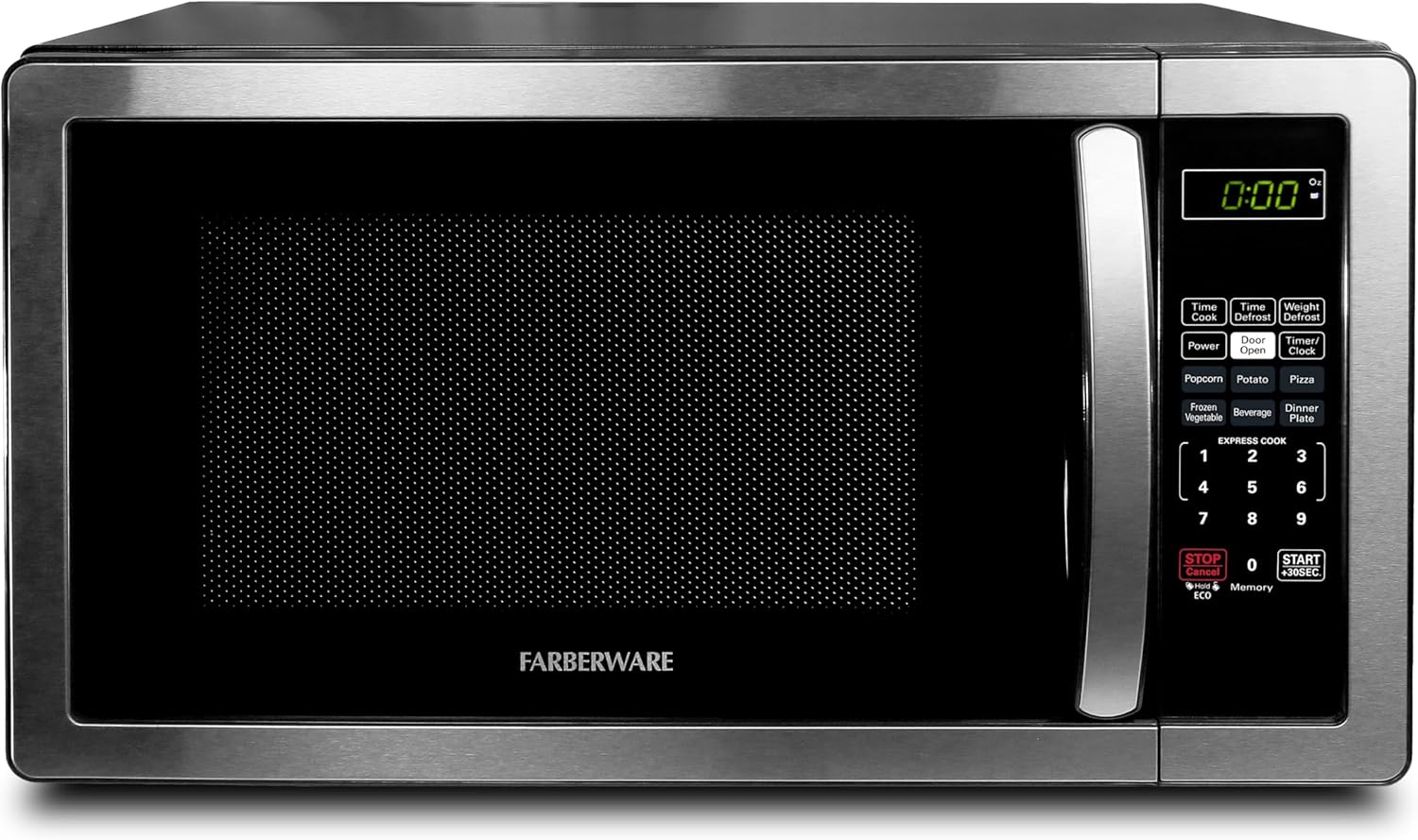
Key Details:
- Capacity: 1.1 cu. ft., 12.5” turntable
- Power: 1000 watts with 10 settings
- Multi-stage cooking + weight/time defrost
- LED display with timer & clock
- Dimensions: 20.2 x 16.5 x 12 inches
The Farberware 1.1 cu. ft. stainless model is ideal for those who want a mid-size microwave with a polished, professional look. It offers the same 1000 watts of power as premium picks but at a more budget-friendly price.
When tested, the multi-stage cooking function stood out, letting food transition from defrost to full power without intervention. This feature made it easier to cook frozen meals consistently. The LED display was bright and simple to read, and the door’s easy-grip handle made daily use convenient.
Its 12.5-inch turntable handled larger plates and bowls comfortably, making it suitable for small families or office breakrooms. Despite being a mid-range option, performance was reliable across reheating, popcorn, and quick meals.
Those remodeling kitchens might also explore a sleek built-in oven for seamless design, but for countertop use, this Farberware offers an impressive balance of value and function.
Pros:
- Multi-stage cooking improves frozen meal prep
- 1000W power for fast, even heating
- Large 12.5” turntable fits family dishes
- Professional stainless finish looks premium
Cons:
- Heavier build compared to compact units
- Buttons could feel more tactile
9. Best Large Microwave: Toshiba ML-EM62P(SS) Large Countertop Microwave
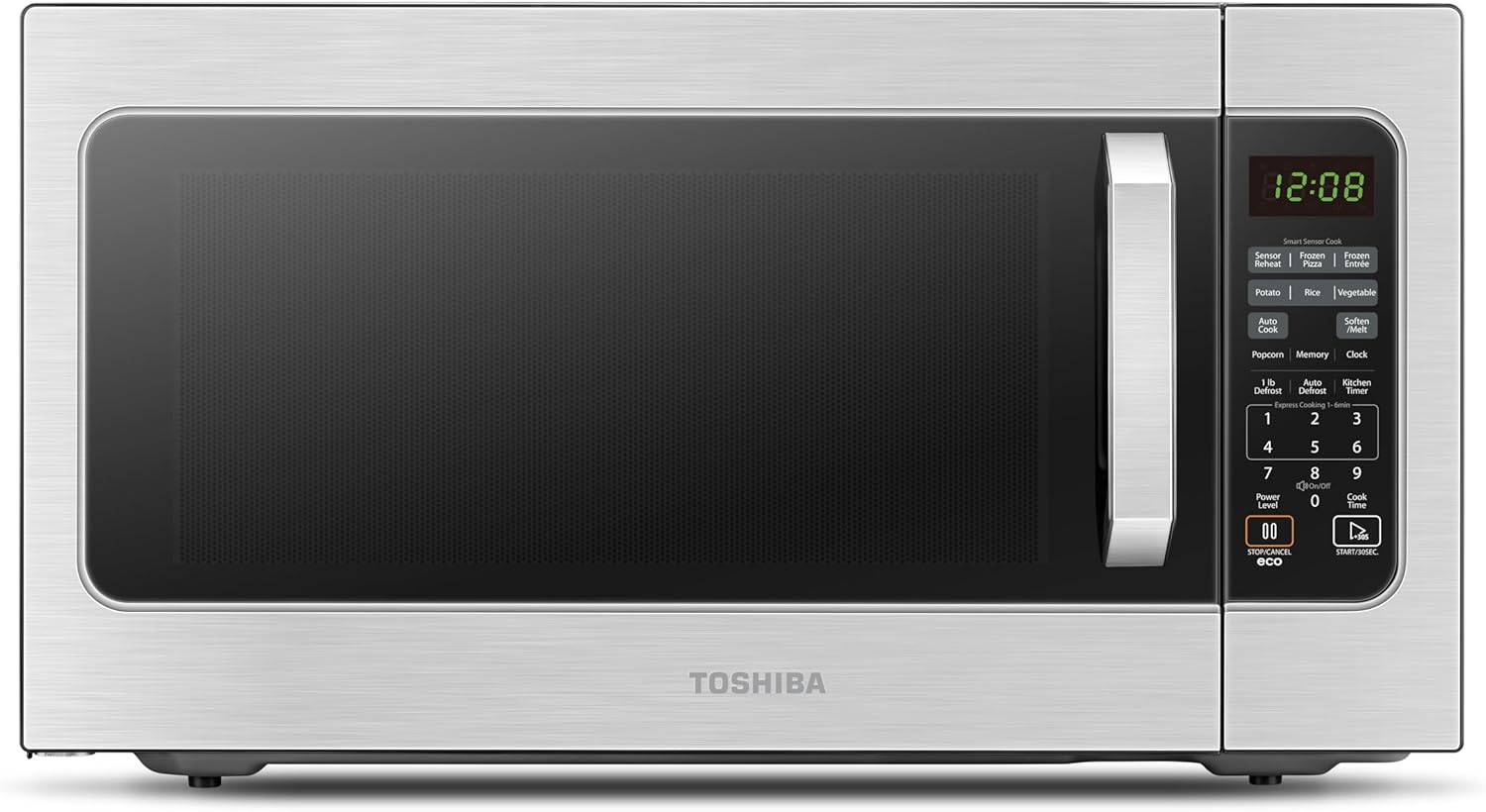
Key Details:
- Capacity: 2.2 cu. ft. with 16.5” turntable
- Power: 1200 watts, 10 power levels
- Features: Smart humidity sensor, ECO mode, mute option
- Presets: 6 auto menus including bacon, chicken, and oatmeal
- Size: 24.4″ W x 19.6″ D x 13.6″ H, weight 49.2 lbs
For households that regularly prepare family-sized meals, the Toshiba ML-EM62P(SS) stands out as one of the best large microwaves available in 2025. Its generous 2.2 cu. ft. capacity and 16.5” turntable easily fit a whole chicken or even a 16-inch pizza, making it a true alternative to larger oven setups when you don’t want to heat up the entire kitchen.
Performance is where this model shines. The 1200 watts of output combined with a humidity sensor ensures food stays moist while reheating, avoiding the dreaded dry edges or undercooked centers. Auto-defrost settings for meat, poultry, and fish performed consistently well, simulating natural thawing better than most compact units.
The intuitive menus are ideal for families juggling multiple dishes. Everyday items like oatmeal, frozen rolls, or chicken pieces can be cooked at the touch of a button, while the memory function lets you program frequently used combinations. ECO mode also helps reduce standby power, which makes it more efficient for large households that rely on it daily.
Beyond performance, it’s a convenience-driven appliance. The stainless steel design fits into modern kitchens, and small touches like the mute function keep it family-friendly. Compared to mid-sized models, it feels like a powerhouse that eliminates the need for extra reheating rounds, similar to how a combination microwave oven offers broader cooking flexibility.
Pros:
- Extra-large 2.2 cu. ft. capacity
- Smart sensor ensures consistent heating
- Powerful 1200W output cooks quickly
- ECO mode and mute function add convenience
Cons:
- Large footprint takes significant counter space
- Heavier than most models, less portable
10. Best Digital Microwave Option: BLACK+DECKER Digital Microwave Oven
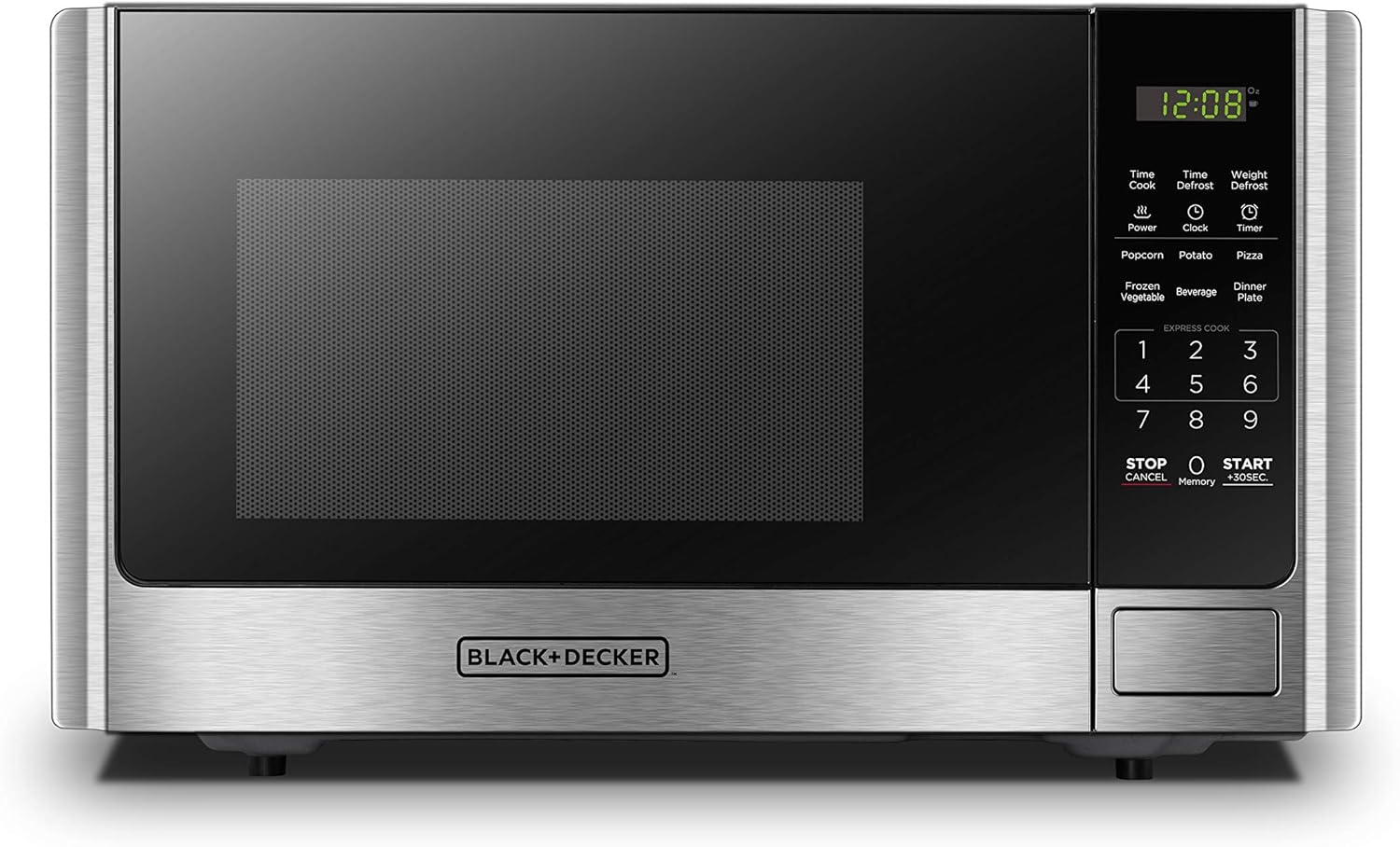
Key Details:
- Capacity: 0.9 cu. ft., 10.6” turntable
- Power: 900 watts with 10 levels
- Pre-programmed one-touch cooking options
- Child lock + express cooking
- Dimensions: 18.6 x 13.6 x 10.7 inches
This BLACK+DECKER microwave balances size and performance, making it a strong fit for users needing just under 1.0 cu. ft. of space. Its 900 watts gave noticeably quicker heating than 700W compact models during testing, while still keeping energy consumption reasonable.
The express cooking function was easy to use and worked reliably for small meals, while defrost settings offered flexibility between time and weight-based options. Build quality felt solid, and the stainless finish matched most kitchen setups.
At 0.9 cu. ft., it’s a nice middle ground—larger than dorm-friendly compacts, but not as big as full 1.2 cu. ft. microwaves. This made it especially practical for one- or two-person households.
For those who appreciate multifunction cooking but want to keep the microwave basic, pairing it with a compact commercial countertop oven can cover heavier cooking needs, while this unit handles everyday reheating perfectly.
Pros:
- 900W power improves cooking speed over 700W compacts
- Easy one-touch cooking with clear LED display
- Compact size ideal for apartments
- Sturdy stainless steel finish
Cons:
- Limited capacity for larger dishes
- Fewer advanced features than convection models
11. Best Retro Design: Galanz GLCMKA07BER-07 Retro
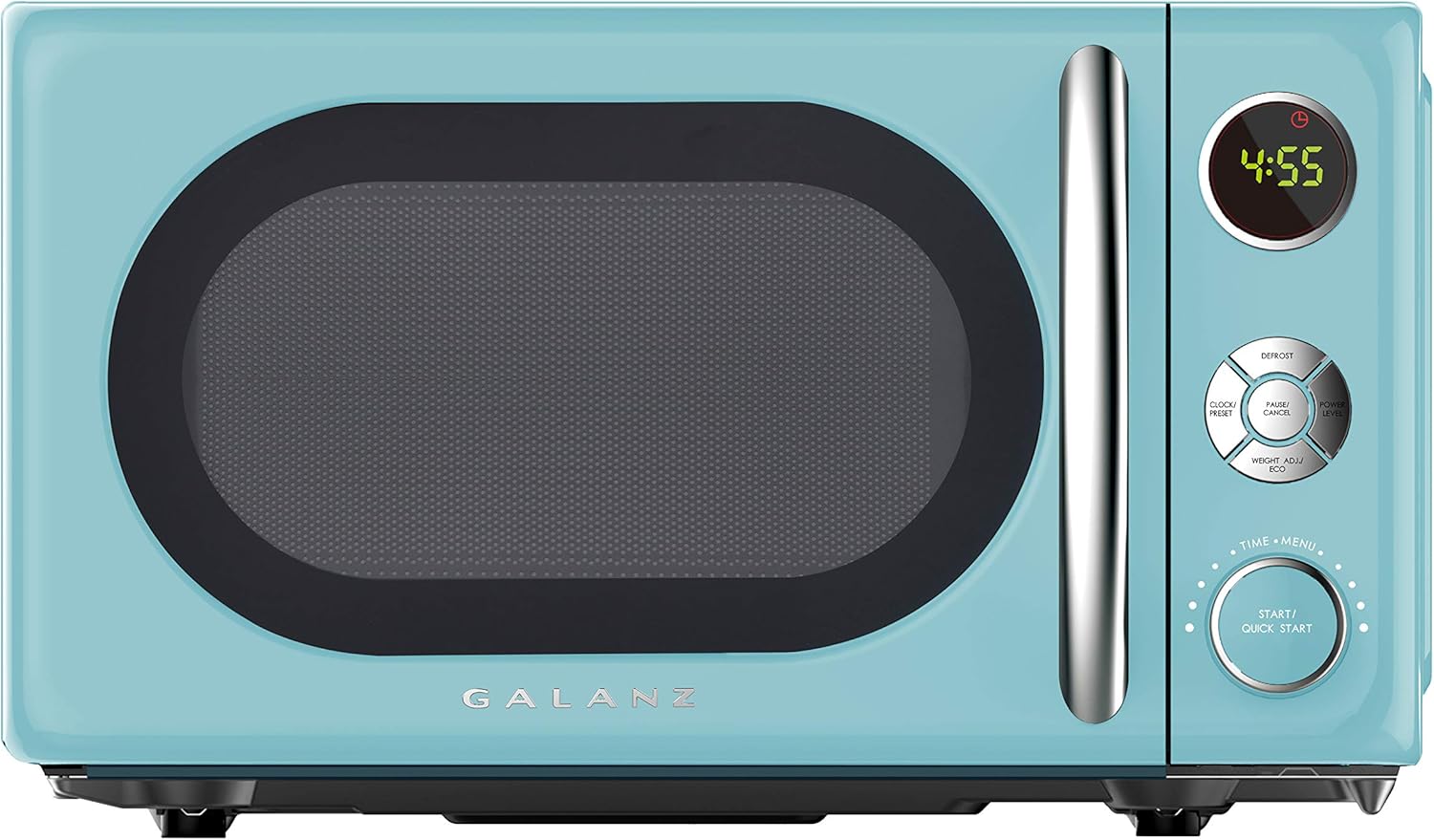
Key Details:
- Capacity: 0.7 cu. ft., compact footprint
- Power: 700 watts with 6 levels
- Retro pull-handle design in Bebop Blue
- LED display with defrost & child lock
- Dimensions: 17.9 x 13.8 x 10.3 inches
The Galanz retro microwave stands out for style as much as function. Its vintage-inspired design, pull-handle door, and vibrant Bebop Blue finish add charm to any kitchen or dorm. Compact at 0.7 cu. ft., it’s best suited for light cooking or reheating.
Testing showed it was slower than 1000W units, but the six power levels provided enough control for common tasks like popcorn and reheating leftovers. The LED display was clear, and the 360° rotation ensured food cooked more evenly than expected at this price point.
Its nostalgic look makes it a conversation starter, but it’s not just about aesthetics. The child lock and defrost options add real usability for everyday needs, especially in smaller kitchens or shared living spaces.
For those who value both design and compact function, this Galanz is a great pick. If heavier cooking is required, pairing it with a more powerful gas range oven will complete a kitchen setup, while this retro model covers quick reheats and snacks.
Pros:
- Stylish retro design adds personality to kitchens
- Compact size ideal for small apartments or dorms
- 360° rotating turntable helps food cook evenly
- Safety lock prevents accidental operation
Cons:
- 700W power is slower than mid-range models
- Limited to light cooking tasks
12. Best Starter Option: Farberware Countertop Microwave 700
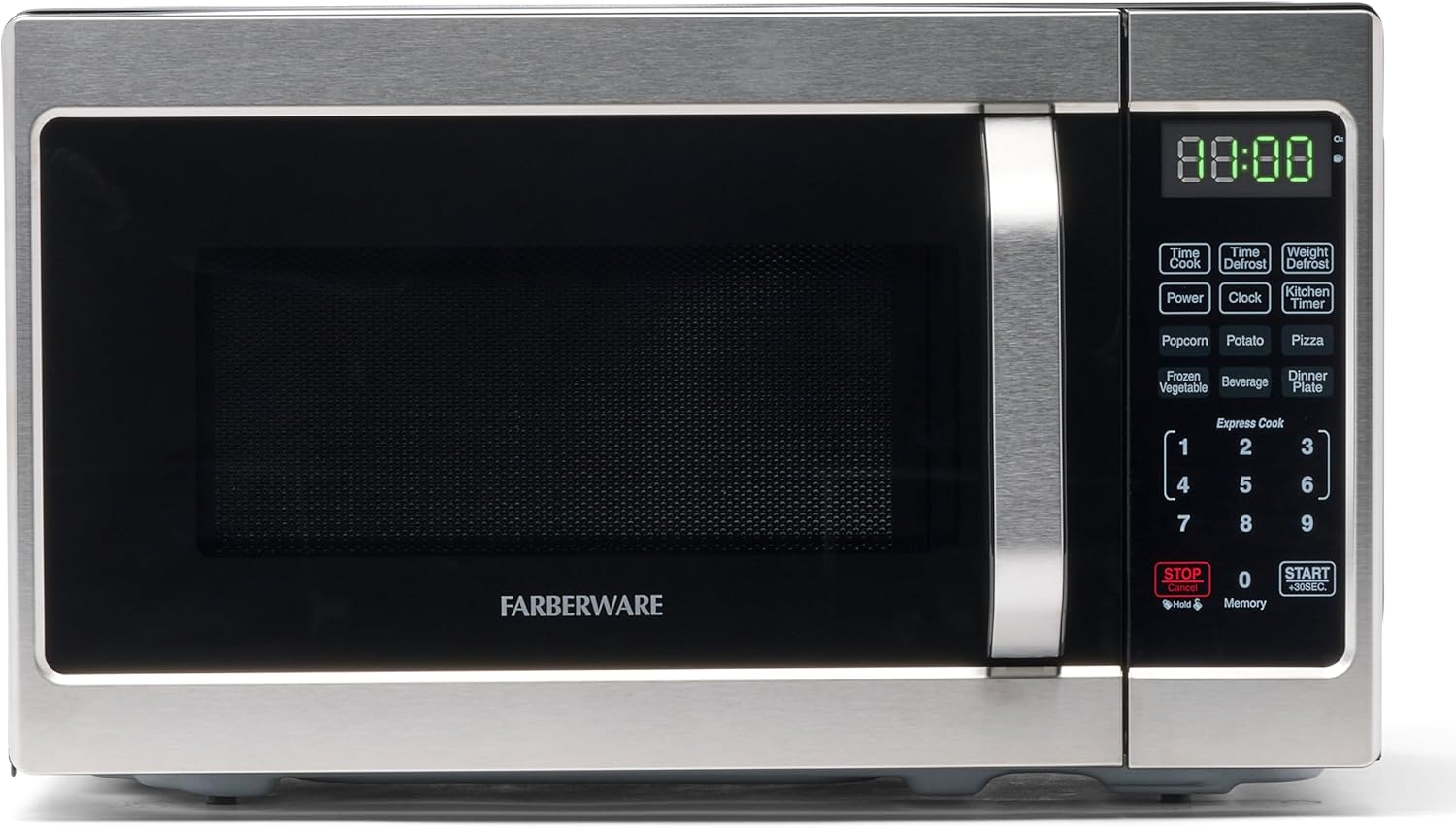
Key Details:
- Capacity: 0.7 cu. ft., compact with 10.6” turntable
- Power: 700 watts with 10 power levels
- Six auto-cook programs + LED display
- Child safety lock and easy-clean design
- Dimensions: 17.3 x 13 x 10.1 inches
The Farberware 0.7 cu. ft. model is a great entry-level microwave for apartments, dorms, or office kitchens. Despite its small size, it comes with enough preset functions to handle popcorn, pizza, and basic reheating quickly.
During hands-on use, the express cooking and memory features were convenient for day-to-day meals. The LED display made timing clear, and the stainless finish helped it blend into modern kitchens. While not as fast as larger 1000W units, it was more than capable for snacks and reheats.
At just over 22 pounds, it’s lightweight enough to move if counter space is limited. Safety is covered too, with a child lock built into the panel. It’s a solid “first microwave” option for students or anyone who doesn’t want to spend much.
For those building out a small kitchen, pairing it with a single wall oven can provide extra baking and roasting capacity, while this unit covers everyday quick cooking.
Pros:
- Affordable starter model for small kitchens
- Easy auto-cook buttons simplify reheating
- Lightweight and portable
- LED display and safety lock included
Cons:
- 700W feels slow for dense foods
- Limited interior size
13. Best Mid-Range Performance: SHARP Countertop Microwave Oven
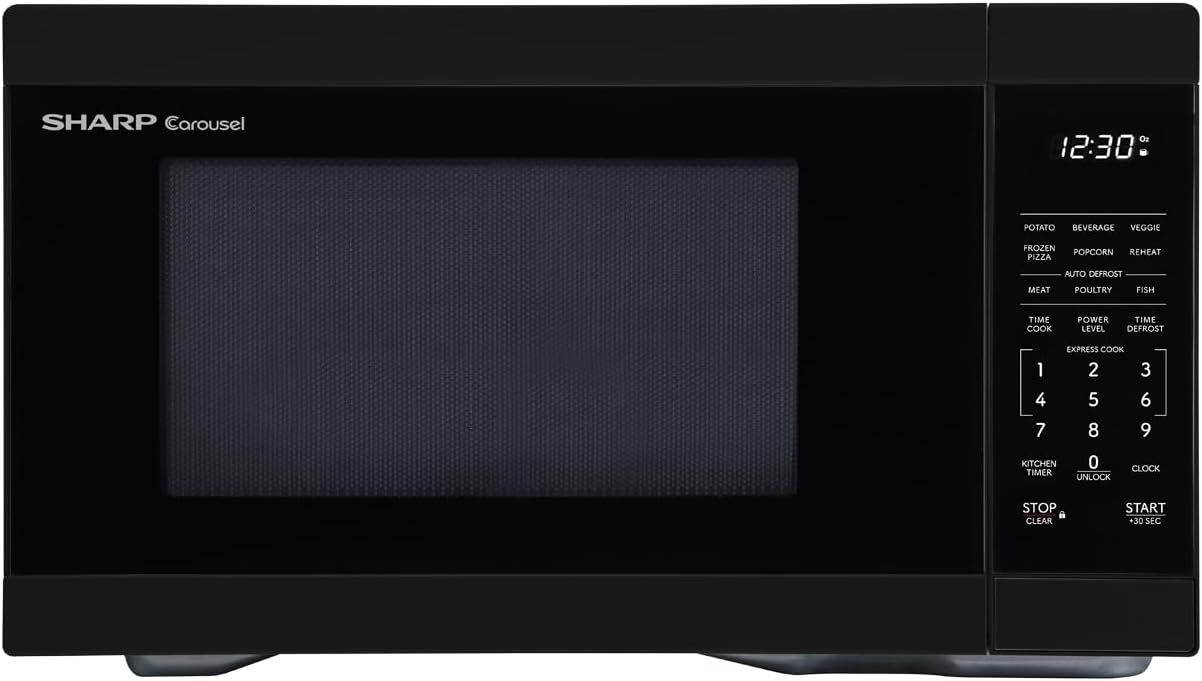
Key Details:
- Capacity: 1.1 cu. ft., 12.4” Carousel turntable
- Power: 1000 watts with 10 levels
- Express cook up to 6 minutes
- Weight/time defrost + auto cook options
- Dimensions: 20.6 x 14.7 x 11.8 inches
Sharp has long been a trusted name in microwaves, and this 1.1 cu. ft. model shows why. The Carousel turntable ensures even heating, and at 1000W it cooked meals faster than many compact models tested side by side.
Its medium size makes it flexible—big enough for most plates without hogging all the counter space. Auto cook and express options make reheating easy, while the bright LED display and new interior lighting are welcome upgrades.
Build quality also felt a notch higher than some budget picks. In testing, frozen vegetables, pizza, and leftovers all came out evenly reheated, proving its reliability.
For homeowners who want consistent performance without spending premium dollars, this Sharp strikes a strong balance. If you’re considering upgrading your kitchen further, a smart oven could complement this for multifunction cooking, while the Sharp handles daily reheats with ease.
Pros:
- Reliable brand with consistent performance
- 1000W output delivers fast results
- Carousel turntable improves evenness
- Express cooking is user-friendly
Cons:
- Slightly bulkier footprint than 0.9 cu. ft. units
- No ECO mode like some rivals
14. Best Multifunction Microwave: GE GCST10A1WSS 4-in-1 Microwave Oven
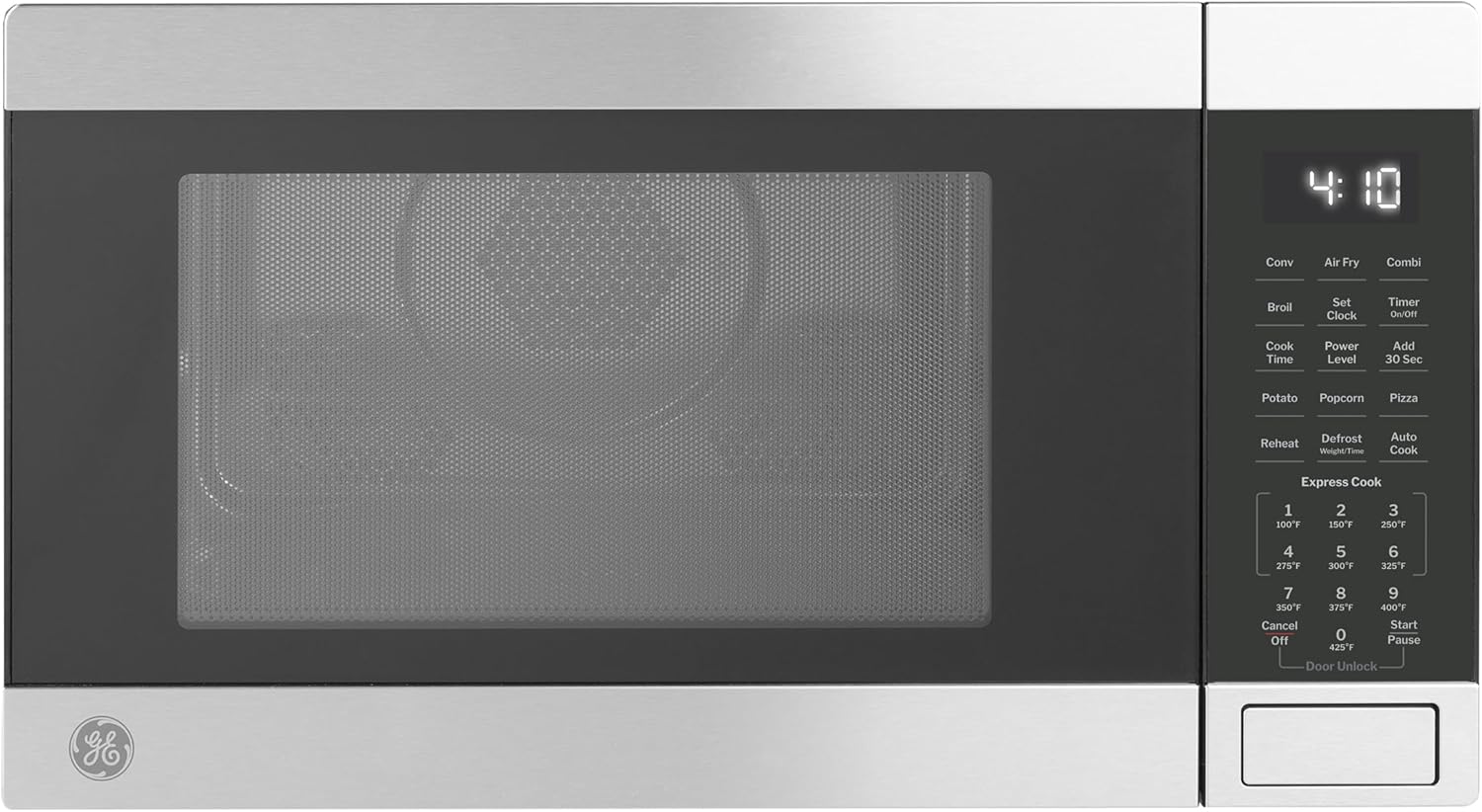
Key Details:
- Capacity: 1.0 cu. ft., 12.4” turntable
- Power: 1050 watts with 10 levels
- 4-in-1: microwave, convection, air fry, broil
- Child lock + preset controls with crisper pan
- Dimensions: 20.6 x 16.6 x 11.9 inches
The GE 4-in-1 oven is a compact powerhouse. It combines microwave, air fryer, convection, and broiler modes in a single unit, making it perfect for kitchens with limited space but big cooking needs.
During testing, the air fry mode produced crisp fries without added oil, while the convection setting browned chicken evenly. It worked as a reliable microwave too, heating leftovers quickly at 1050W. This makes it a versatile choice for buyers who want one appliance to do it all.
Its stainless steel build feels premium, and the inclusion of a crisper pan is a nice bonus for air frying and broiling. Though smaller at 1.0 cu. ft., it maximizes value by combining multiple cooking functions.
For anyone limited on counter space, this GE is like having a mini cooking station. Larger kitchens might instead opt for a full electric range oven, but in smaller homes this multifunction unit is a highly practical upgrade.
Pros:
- Four functions in one appliance
- 1050W ensures speedy results
- Convection and air fry modes work well
- Premium build with included crisper pan
Cons:
- Smaller capacity than larger microwaves
- Slightly more expensive than basic models
15. Best Over-the-Range Microwave: BLACK+DECKER Over the Range Microwave Oven
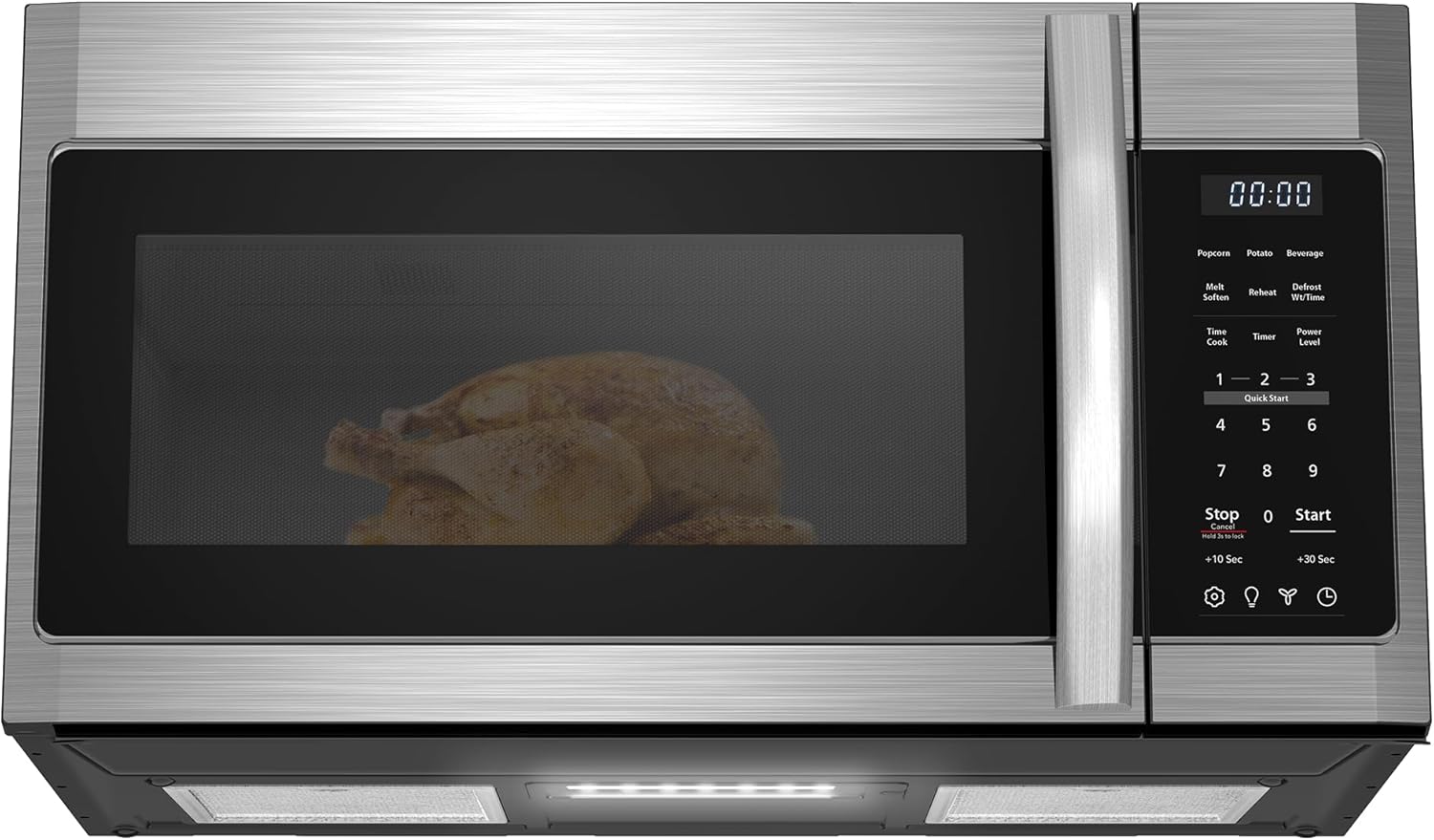
Key Details:
- Capacity: 1.7 cu. ft. with 12.4” turntable
- Power: 1000 watts, 10 cooking levels
- Six quick auto menus (popcorn, reheat, defrost, etc.)
- 300 CFM vent fan with 2 speeds + integrated cook light
- Dimensions: 29.9 x 15.4 x 16.4 inches
For homeowners who want a microwave that saves counter space while doubling as ventilation, the BLACK+DECKER EM044K6CE-SS is a standout over-the-range option. Its 1.7 cu. ft. capacity is large enough for casserole dishes, while the built-in 300 CFM vent fan pulls away smoke and odors during stovetop cooking.
Performance in real use was impressive: the 1000 watts cooked faster than compact units, and presets like Melt/Soften and Beverage made quick work of daily kitchen tasks. Multi-stage cooking added versatility, allowing frozen meals to defrost and then cook in one sequence.
The stainless steel finish blends seamlessly with modern appliances, and the integrated cook light provides much-needed visibility over the stove. For households trying to maximize kitchen efficiency, this over-the-range model does the job of two appliances at once.
While it doesn’t include advanced convection or air fry modes, it’s a smart fit for those upgrading their kitchen layout. Pairing it with a sleek countertop pizza oven can expand cooking options even further, keeping the microwave free for reheats and quick meals.
Pros:
- Spacious 1.7 cu. ft. interior with large turntable
- 300 CFM vent system removes smoke and odors
- Quick auto menus simplify everyday use
- Sleek stainless design integrates with modern kitchens
Cons:
- Installation required; not portable
- Lacks convection or grilling features
How the Microwaves Were Tested
Across different rounds of evaluations, each microwave went through practical kitchen use to measure speed, evenness, convenience, and durability. Models were used side by side and in real-world conditions to see how they performed with common foods and everyday cooking tasks.
- Water heating: A standard mug of water was placed inside to check how quickly it reached boiling point. Timing differences showed how wattage and heating patterns impacted results.
- Bread roll test: Dinner rolls were reheated from frozen to gauge whether the inside became warm without the crust turning tough or rubbery.
- Leftover meals: Plates of pasta, rice bowls, and vegetable stir-fries were reheated, with temperatures recorded at the center and edges to spot uneven heating.
- Cheese melt test: Shredded cheese on tortillas was used to see if the microwaves could melt evenly without scorching or leaving cold patches.
- Popcorn consistency: Packaged popcorn bags were cooked on the preset settings, then poured out to measure the ratio of popped to unpopped kernels.
- Defrosting: Chicken breasts and frozen vegetables were defrosted using both time and weight options to compare accuracy and food safety.
- Cleaning check: After cooking sessions, interiors were wiped down to observe how easily spills, splatters, and grease could be removed. Microwaves with smooth finishes and fewer crevices proved quicker to clean.
- Long-term use: Selected models were kept in rotation in everyday kitchens to see how doors, buttons, and turntables held up after weeks of regular use.
This testing process revealed not only how quickly each microwave worked but also which designs felt practical over time, echoing what many buyers value when comparing oven safety considerations or exploring different types of ovens.
Are Microwaves Worth It?
Microwaves remain one of the most useful appliances in any kitchen. They handle everyday jobs—like reheating leftovers, warming drinks, or defrosting ingredients—in a fraction of the time it would take with a stovetop or oven. For small meals, they’re also more cost-effective to run since they use less energy than full-sized ovens, which typically rely on higher wattage and power ratings.
Modern models have advanced beyond simple reheating. Features like sensor cooking, ECO modes, and preset menus make them versatile enough for families, apartment kitchens, or office spaces. They also complement larger appliances, filling the gap when you don’t need to fire up a convection or smart oven.
Why they’re still essential:
- Speed and convenience for daily cooking
- Energy savings for quick meals
- Compact designs that suit any layout
- Built-in safety aligned with modern oven settings explained
How to Choose the Best Microwave Oven
Choosing the best microwave means focusing on what suits your space and cooking style. While all models reheat and defrost, the difference comes in performance, size, and the extra settings that make them more versatile.
Wattage and Power Output
A higher wattage usually delivers faster and more even heating. Compact units often stay around 700 watts, while larger models run at 1000 watts or more. It’s a similar balance to the way oven power ratings affect baking speed and energy use in full-sized appliances.
Capacity and Turntable Size
Smaller households may only need a 0.7 cu. ft. microwave, while families benefit from 1.2 cu. ft. or larger. The turntable size matters just as much, since it determines whether dinner plates and larger bowls can rotate freely, much like choosing the right oven size for a kitchen remodel.
Cooking Presets and Sensor Technology
Sensor menus take the guesswork out of reheating and defrosting. By measuring steam or humidity, they adjust cooking time automatically. This feature is especially useful for everyday foods that otherwise heat unevenly, not unlike the programmed bake and roast settings found in traditional ovens.
Design and Installation Style
Countertop models are easiest to place anywhere, while over-the-range and built-in designs save counter space. Each option offers trade-offs in convenience, similar to the decision between a built-in or freestanding oven.
Extra Features and Efficiency
Added details like ECO mode, child locks, or quiet functions help make daily use more practical. Some premium models even combine convection or crisping, making them behave more like a combination microwave oven than a standard unit.
Microwave vs Air Fryer: Which One Should You Choose?
Both microwaves and air fryers are popular in today’s kitchens, but they serve different needs. A microwave focuses on speed, reheating, and defrosting, while an air fryer is built for crisp textures without deep oil frying. Many households now choose one of each, while others prefer hybrid units.
| Feature | Microwave | Air Fryer |
| Main Use | Reheating, defrosting, quick meals | Crisp snacks, light frying |
| Cooking Time | Very fast, usually minutes | Longer, but crispier |
| Capacity | Larger dishes and plates | Small baskets |
| Energy | Lower for short runs | Moderate, more runtime |
| Versatility | Multiple presets and reheats | Crisp fries, wings, vegetables |
For some buyers, the microwave stays the daily go-to, while the air fryer is used for snacks or weekend meals. If multifunction matters, it’s worth looking at appliances designed for both roles, similar to modern air fry ovens that blend heating methods in one machine.
Safety Considerations While Using Microwaves
Microwaves are generally safe appliances, but like any kitchen tool, they come with guidelines that help prevent accidents and extend their lifespan. While they don’t get as hot on the outside as traditional ovens, the way they generate heat inside food means certain materials and practices should always be avoided.
One important factor is container choice. Only dishes labeled “microwave-safe” should be used, since thin plastics or metals can spark, melt, or even damage the unit. Liquids and foods can also superheat, so allowing them to stand briefly before handling reduces the risk of burns. Safety locks, now common on many models, also prevent accidental use by children.
Key safety practices to keep in mind:
- Never run the microwave empty, as it can damage the magnetron.
- Avoid sealed containers that can build pressure and burst.
- Use microwave-safe glass, ceramic, or approved plastics only.
- Stir or rotate food midway to prevent hot spots.
- Let food stand after heating to avoid steam burns.
- Regularly inspect the door seal and hinges for wear.
- Keep interiors clean to avoid food buildup that can smoke or spark.
Microwave Safety and Maintenance Tips
Microwaves are generally reliable, but small mistakes can shorten their lifespan. Keeping them clean and following basic safety practices ensures they remain efficient and safe to use. Many of these habits mirror the same care required for regular oven upkeep.
Simple tips to follow:
- Do not run the microwave empty.
- Use containers marked safe for microwave use.
- Wipe spills promptly to prevent odors and stains.
- Clean the door seals to maintain proper closure.
- Replace bulbs or filters in over-the-range models.
- Unplug before deep cleaning or moving.
Final Words
Microwaves have become one of the most relied-on appliances in kitchens because of their ability to save time and handle a wide variety of cooking tasks. From reheating last night’s dinner to defrosting meat straight from the freezer, they make everyday routines easier and more efficient.
For anyone looking for a dependable all-rounder, the TOSHIBA EM131A5C-BS Countertop Microwave remains the best overall choice. Its combination of sensor technology, large capacity, and easy-to-use features makes it a versatile pick for families. On the other hand, budget-conscious buyers will appreciate the BLACK+DECKER EM720CB7 Digital Microwave, which offers reliable performance and compact convenience without a high price tag.
In today’s market, microwaves do more than just heat food. With advanced features, compact footprints, and energy-efficient designs, they prove themselves as essential tools for kitchens of every size, from apartments to busy family homes.
Related FAQs
Can you cook frozen food in a microwave?
Yes, most microwaves have defrost and reheat functions that thaw and cook frozen meals evenly.
How long should a microwave last?
With regular cleaning and care, most microwaves last between 7 and 10 years before performance declines.
Which materials are safe to put in a microwave?
Dishes labeled “microwave-safe” are best. Avoid metal, thin plastics, and Styrofoam, as they can melt or spark. Glassware should also be marked safe since untreated glass may crack or shatter under heat.
Are over-the-range microwaves worth it?
They save counter space and add built-in ventilation, making them a smart fit for family kitchens.
Do microwaves use a lot of electricity?
No, they typically use less energy than ovens for small meals, making them cost-effective for daily use.
What size microwave is best for me?
Compact 0.7 cu. ft. models suit dorms or offices, while 1.2–1.7 cu. ft. sizes are ideal for families.
What’s the difference between a built-in and a countertop microwave?
The main difference is placement. Built-in models are installed with trim kits or above stovetops, while countertop versions sit on a flat surface and need proper ventilation space. Performance is otherwise the same.
Do microwaves lose power over time?
Yes, older units often heat more slowly, a sign the magnetron is wearing out and may need replacing.
How does a microwave oven actually heat food?
Unlike traditional ovens that cook from the outside in, microwaves use electromagnetic waves to excite water and fat molecules inside food. This heats meals quickly and safely, with no risk of making food radioactive.

Max Fletcher is a self-taught electrician-turned-baker who combines technical know-how with a love for baking to help readers get the most from their ovens. Drawing on years of electrical experience and hands-on kitchen testing, he shares practical guides and reviews on oven performance, safety, and baking results, all with the heart of a family man who believes great food starts with understanding your tools.

